Are Your Trees Thirsty? How Plumbing Leaks Can Attract Invasive Roots
Are your trees thirsty? It’s more than just a gardening concern; in fact, are your trees thirsty? How plumbing leaks can attract invasive roots is a crucial topic to consider. Plumbing leaks can make a prime target for invasive roots, causing severe damage to your pipes. Understanding how and why tree roots invade sewer lines is critical to protecting your home. This article will explore why trees seek out these leaks, the signs of root intrusion, and effective prevention methods.
Key Takeaways
Tree roots are highly skilled at locating plumbing leaks, especially during dry seasons, leading to potential sewer line invasions.
Common signs of tree root intrusion include slow drains, foul odors, and unexpected spikes in water bills that necessitate timely intervention.
Preventive measures such as regular inspections, root barriers, and mindful landscaping practices are essential to protect plumbing systems from invasive roots.
Why Trees Seek Out Plumbing Leaks
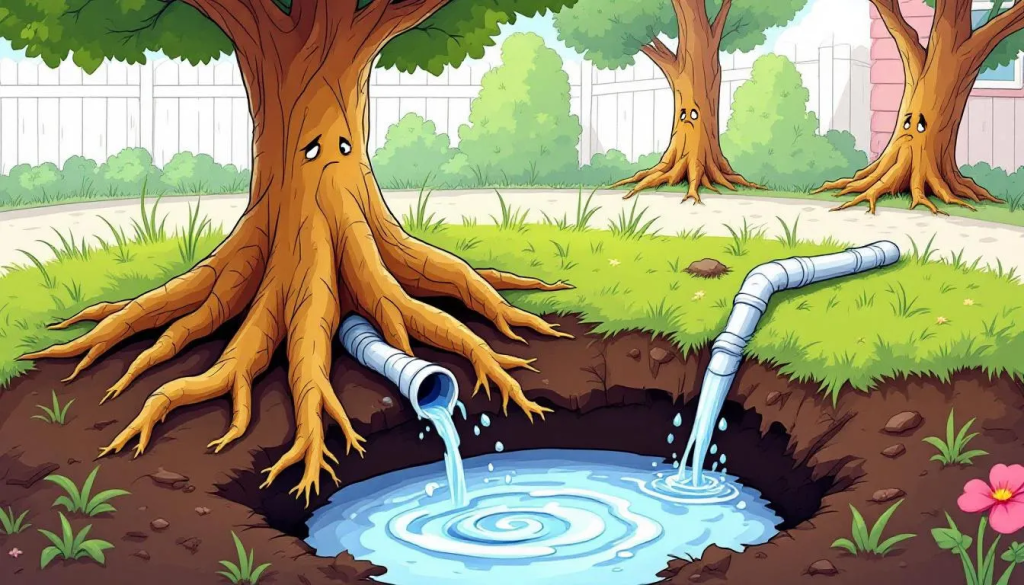
Tree roots are nature’s underground explorers, constantly searching for water and nutrients to support their growth. When the surrounding soil lacks moisture, thirsty tree roots pose particularly aggressive in their search, often zeroing in on leaking sewer pipes and drain lines as convenient sources of hydration. This phenomenon is especially pronounced during dry seasons, when thirsty trees and thirsty roots are desperate for water.
But why are tree roots so adept at finding these plumbing leaks? It’s because they can detect moisture from a considerable distance. Older pipes with cracks or leaks are prime targets, as they release water into the surrounding soil, creating an irresistible oasis for nearby tree roots. Older sewer systems are especially vulnerable to root intrusion due to their aging infrastructure.
Certain tree species, like willows and maples, as well as fast growing trees and large trees with aggressive root systems, are notorious for their ability to invade sewer lines. Understanding these natural tendencies is the first step in preventing tree root intrusion into your plumbing system.
How Tree Roots Detect Moisture
Tree roots are incredibly efficient at locating moisture, even from tiny leaks in sewer pipes. Key characteristics include:
Roots grow horizontally just beneath the soil’s surface, spreading out in search of water sources.
Under favorable conditions, roots can grow as much as one foot per day towards a moisture source, showing remarkable persistence.
Poorly drained soil encourages roots to concentrate where water collects.
This concentration can lead to potential root infiltration into sewer lines.
Signs of root intrusion based on moisture detection include wet spots in your yard or unusually lush green areas during dry conditions. These are a warning sign that tree roots have found a way into your underground pipes, creating extensive networks within the sewer system. Recognizing these signs of excess moisture early can help prevent more significant plumbing issues down the line.
Nutrient Attraction
Beyond moisture, tree roots are also attracted to the nutrients found in wastewater. Underground sewer lines that transport nutrient-rich wastewater are particularly prone to tree root invasion. Roots enter through existing cracks or joints in the pipes, drawn by the promise of water, air, and essential nutrients.
This nutrient attraction accelerates root growth and can lead to significant blockages if not addressed promptly, impacting future root growth and attract roots.
Common Signs of Root Intrusion in Sewer Lines
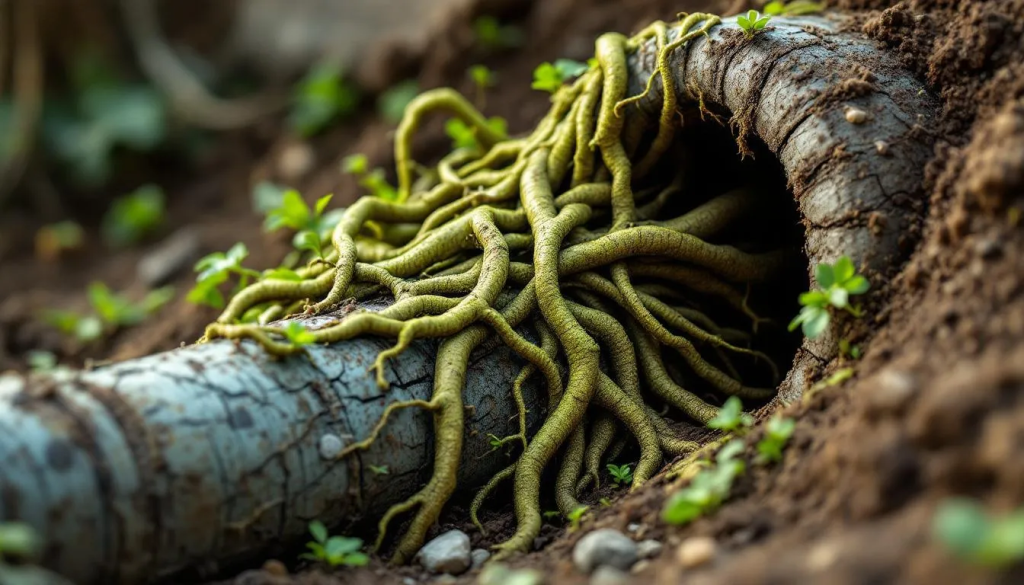
Recognizing the signs of root intrusion early can save you from extensive damage and costly repairs. Common symptoms include slow drains, unexpected gurgling sounds, and foul odors emanating from your plumbing fixtures. These symptoms often indicate that tree roots have infiltrated your sewer lines, obstructing water flow and causing backups.
Ignoring these warning signs can lead to more severe problems, such as complete clogs, sewage backups, and unsanitary conditions. Backups may be especially noticeable when using multiple fixtures simultaneously, such as flushing a toilet while running a sink, which can overwhelm the sewer system and trigger a backup. By being vigilant and addressing these issues promptly, you can prevent extensive damage to your plumbing system and avoid expensive repairs.
Slow Drains
One of the earliest signs of tree root intrusion is slow drainage in your plumbing system. If you notice that your bathtub drains or bathroom sink is taking longer than usual to empty, it’s likely that tree roots are obstructing the flow in your sewer pipes.
Slow drains can be an early indication of more significant plumbing issues, and recognizing this symptom is crucial for proactive maintenance.
Foul Odors
Unpleasant smells coming from your drains are another red flag for tree root intrusion. These foul odors result from wastewater accumulation due to root blockages. If you detect such smells, it’s essential to seek sewer cleaning services to address the root cause and prevent further complications.
Increased Water Bills
An unexpected increase in your water bills can also signal tree root intrusion. As roots invade your sewer lines, they can cause leaks that lead to higher water consumption. These leaks not only waste water but also result in costly repairs if left untreated.
Monitoring your water bills for unusual spikes can help you catch these issues early and address them before they escalate.
How Plumbing Leaks Worsen Over Time
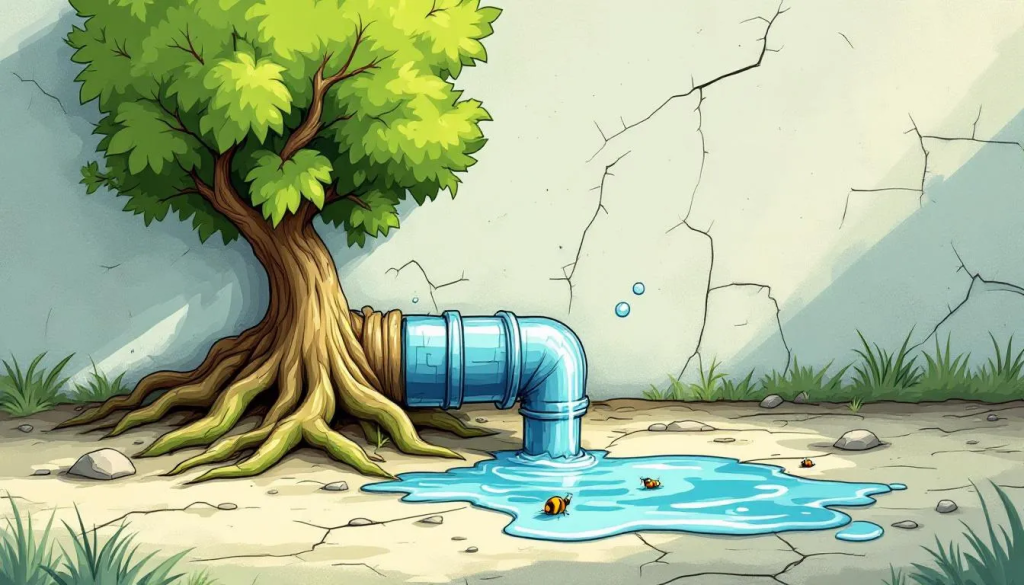
Plumbing leaks that attract tree roots are like ticking time bombs. Over time, these leaks can worsen, leading to more severe plumbing issues. Factors such as damaged pipes, aging infrastructure, and lack of maintenance contribute to the problem. The sewer lateral, which connects your home to the main sewer line, is especially vulnerable to root intrusion and deterioration over time. As tree roots grow larger, they exert increased pressure on the pipes, exacerbating existing leaks and causing further damage.
Ignoring plumbing leaks can result in extensive property damage and costly repairs. Older sewer lines, particularly those made of materials prone to cracking, are especially vulnerable to root intrusion. Promptly addressing leaks can prevent tree roots from causing major disruptions in your plumbing system.
Crack Propagation
Cracks in pipes often develop as a result of persistent leaks. When tree roots grow through these cracks, they expand and create blockages that can wreak havoc and lead to noticeable wet patches in your yard.
Regular annual maintenance drain cleaning helps ensure that pipes remain in good condition, reducing the risk of crack development and subsequent root intrusion.
Soil Erosion and Pipe Damage
Soil erosion around leaky pipes can lead to instability, as the ground supporting the pipes becomes compromised. This instability causes pipes to sag or shift position, creating stress points that invite more invasive tree roots. As a result, the plumbing issues worsen, leading to significant damage if not addressed promptly.
Addressing soil erosion is crucial in preventing further damage to pipes and the invasive root growth it attracts in the affected area. By stabilizing the surrounding soil and repairing leaks promptly, you can protect your plumbing system from the detrimental effects of soil movement and root infiltration.
Types of Pipes Most Vulnerable to Root Invasion
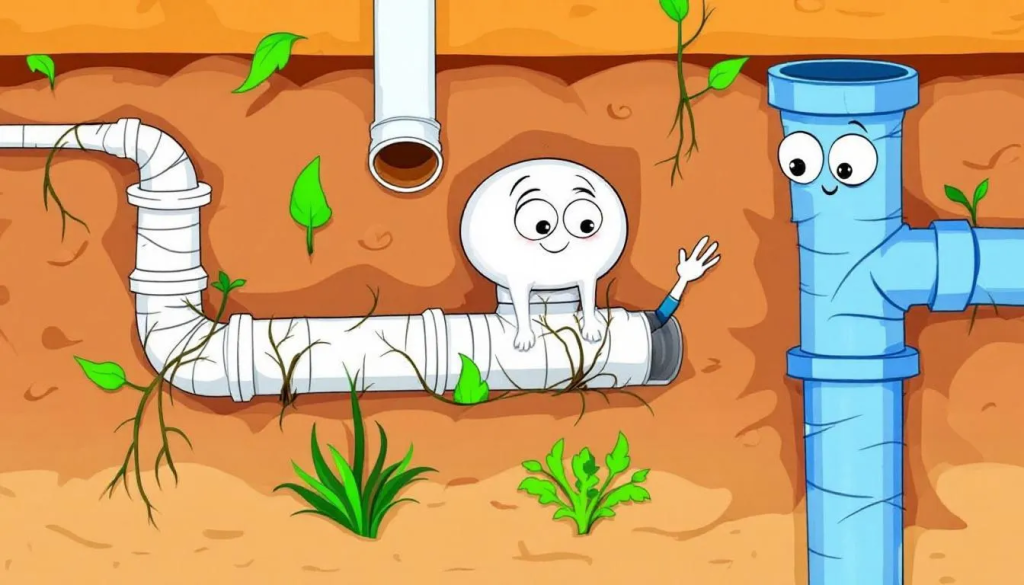
Different types of pipes offer varying degrees of resistance to root intrusion. Older materials like clay, concrete, and cast iron are particularly susceptible to damage from invasive roots. These pipes often have weak spots that tree roots can exploit, leading to significant plumbing issues.
Understanding the vulnerabilities of each pipe type can help you take preventive measures to protect your plumbing system.
Clay Pipes
Clay pipes are often found in homes constructed before the 1970s. These pipes are particularly susceptible to root intrusion. Small cracks and gaps in these pipes provide entry points for tree roots, which can expand inside and cause further damage. Although durable and non-corrosive, clay pipes are prone to weakness from soil movement and shifting foundations.
Cast Iron Pipes
Cast iron pipes, while sturdy, are prone to corrosion over time due to environmental factors. As these pipes corrode, they develop tiny cracks that allow tree roots to gain access.
If roots infiltrate cast iron pipes, they can expand and choke the sewer line, leading to potential emergency situations.
PVC Pipes
PVC pipes are generally more resistant to root intrusion due to their low permeability and flexibility. However, they can still suffer from root invasion if wastewater leaks occur, especially if the pipes are improperly installed.
Ensuring proper installation and maintenance of PVC pipes is essential to prevent root-related plumbing issues.
Consequences of Neglect
Neglecting tree root intrusion in your sewer pipes can have far-reaching consequences for property owners. When root growth is left unchecked, it doesn’t just threaten the integrity of your plumbing system—it can also lead to mounting repair bills, health hazards, and environmental damage. Understanding these risks is essential for anyone looking to protect their home and community from the hidden dangers of invasive roots.
Escalating Repair Costs
When tree root intrusion is ignored, the damage to your sewer lines can quickly spiral out of control. Invasive roots can infiltrate sewer pipes, causing persistent slow drains, clogged drains, and even complete blockages. Over time, these invasive root systems can wreak havoc on your plumbing systems, leading to cracked or collapsed pipes that require extensive pipe replacement or main sewer line repairs.
The longer root intrusion is left unaddressed, the more invasive roots will grow and the more expensive the repairs become. What might start as a minor blockage can escalate into a major plumbing emergency, often requiring excavation and replacement of entire sections of your sewer line. Regular drain cleaning services and timely plumbing diagnosis are crucial to catch these issues early and avoid the costly repairs that come with advanced root damage.
Health and Safety Risks
Tree root intrusion in sewer lines isn’t just a plumbing problem—it can also pose serious health and safety risks for property owners. When tree roots block or damage sewer lines, sewage can back up into your home or yard, creating unsanitary conditions and increasing the risk of disease transmission. Contaminated water and raw sewage can seep into the surrounding soil, further endangering your family’s health.
Excess moisture from leaking pipes also attracts more thirsty tree roots, fueling additional root growth and compounding the problem. This cycle can lead to ongoing plumbing issues and create an environment where invasive roots thrive. Practicing proper landscaping and maintaining your plumbing system are essential steps to protect your property and ensure a safe, healthy living environment.
Environmental Impact
The environmental consequences of neglecting tree root intrusion in sewer lines can be significant. Damaged sewer lines may leak untreated wastewater into the surrounding soil, polluting local waterways and harming nearby ecosystems. This contamination can disrupt plant and animal life, degrade water quality, and contribute to broader environmental problems.
Additionally, relying on harsh chemical treatments to remove roots can have negative effects on the environment. Instead, property owners are encouraged to use eco-friendly solutions like hydro jetting and to plant trees with less invasive root systems to prevent future root intrusion. Regular maintenance, including routine inspections and drain cleaning services, not only helps remove roots before they cause major issues but also minimizes the environmental impact of plumbing problems. By taking proactive steps, you can protect both your property and the environment from the damaging effects of invasive root systems.
Preventive Measures Against Root Intrusion
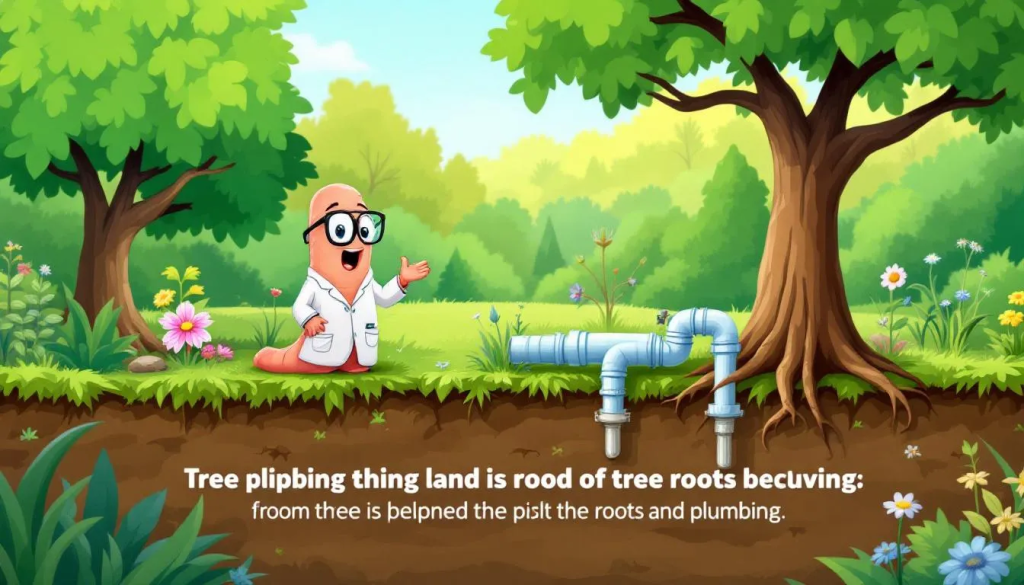
Preventing tree root intrusion requires a proactive approach that includes regular maintenance, strategic landscaping, and the use of root barriers. To reduce the risk of root intrusion, avoid planting trees near sewer lines and underground utility lines. Before planting trees, homeowners should identify the location of all utility lines to prevent accidental damage. Conducting annual inspections can help identify early signs of root intrusion and leaks, allowing for timely intervention.
Installing root barriers and practicing proper landscaping can further protect your plumbing system from invasive roots and rooter plumbing. When selecting recommended trees for planting, it is important to consider the types of trees planted and ensure they are placed at a safe distance from utility lines and sewer pipes to minimize the risk of root-related issues.
Regular Inspections
Regular plumbing inspections are crucial for early detection of root intrusion and leaks. Property owners should schedule these inspections with a professional who can use advanced tools like CCTV drain cameras to assess the condition of the main sewer line and sewer lines.
Routine drain cleaning services and attention to signs of clogged drains can help maintain the health of the drain line plumbing system through routine maintenance.
Root Barriers
Root barriers effectively prevent tree roots from invading sewer lines and serve as a protective measure to maintain the integrity of sewer systems. Key points about root barriers include:
Made from materials like plastic or metal
Can redirect roots away from the plumbing system
Proper installation is crucial
Barriers should be buried at a depth of 12 to 24 inches to provide adequate protection
In addition to physical barriers, methods such as deep planting can also help block tree roots from reaching sewer lines. Root barriers should allow water and nutrients to pass through, ensuring the health of nearby plants. By implementing these measures, homeowners can effectively protect their plumbing systems from invasive roots.
Proper Landscaping Practices
Proper landscaping practices play a significant role in preventing root intrusion. Homeowners should choose smaller plants with less invasive root systems when landscaping near sewer lines. Avoiding tree and shrub species with aggressive root systems can prevent potential damage to sewer pipes.
Recommended trees for planting near sewer lines include crape myrtles, dwarf citrus trees, smaller trees like small acacias. It’s advisable to plant these trees at least 10 feet away from sewer lines to reduce the risk of root damage.
Thoughtful landscaping choices can secure plumbing health while preserving the beauty of your garden.
Effective Methods to Remove Roots from Pipes
When tree roots have already infiltrated your pipes, several methods can be used to remove them. Mechanical and chemical approaches are commonly employed, each with its advantages and limitations. Hydro jetting, for example, uses a high pressure hose to deliver powerful streams of water that clear roots and debris from pipes.
Hiring professionals for root removal is essential to ensure safe and effective results.
Hydro Jetting
Hydro jetting is a powerful method that uses high-pressure water to break through tree roots in pipes. This technique is often used after mechanical augers have cleared the initial blockage.
It’s crucial to consider the age and pipe material of the pipes when using hydro jetting to choose the appropriate pressure level.
Mechanical Augers
Mechanical augers are tools designed to cut through and remove tree roots from pipes. These mechanical drilling augers break the roots into small pieces, effectively clearing the affected sewer lines.
While effective, mechanical augers may need to be followed by other methods to ensure complete root removal.
Chemical Treatments
Chemical treatments, such as foaming root killer, are effective for eliminating roots that invade pipes. Common chemicals used include copper sulfate and various foaming agents, and the chemical treatment can enhance their effectiveness.
Consulting with a licensed plumber before using chemical treatments ensures safety and efficacy.
Summary
The complex interplay between plumbing leaks and thirsty tree roots can lead to significant disruptions in your plumbing system. From their relentless search for water and nutrients to the telltale signs of root intrusion, understanding these dynamics is crucial for maintaining a healthy plumbing system. Regular inspections, proper landscaping practices, and the installation of root barriers are essential preventive measures that can save homeowners from the headaches and costs associated with invasive roots.
Addressing plumbing leaks promptly, choosing the right types of pipes, and employing effective root removal methods can protect your home from extensive damage. By taking proactive steps, you can ensure that your plumbing system remains free from the invasive clutches of thirsty tree roots, preserving the integrity and functionality of your home’s infrastructure.
Frequently Asked Questions
How do tree roots detect plumbing leaks?
Tree roots detect plumbing leaks by sensing moisture from cracks in pipes and are drawn to areas with increased water availability. This process leads them to grow toward poorly drained soil, indicating the presence of leaks.
What are the common signs of root intrusion in sewer lines?
If you notice slow drains, foul odors, or rising water bills, these could be clear signs of root intrusion in your sewer lines. It’s important to address these symptoms promptly to prevent further damage and backups.
Which types of pipes are most vulnerable to root invasion?
Older pipes, especially those made from clay, concrete, and cast iron, are most vulnerable to root invasion due to their susceptibility to cracks and weaknesses from environmental factors. Prioritizing replacement or repair of these materials can help mitigate the risks associated with root intrusion.
How can homeowners prevent tree root intrusion into their plumbing systems?
Homeowners can effectively prevent tree root intrusion into their plumbing systems by conducting regular plumbing inspections, installing root barriers, and practicing thoughtful landscaping. Additionally, opting for less invasive tree species and planting them away from sewer lines significantly reduces the risk of root-related issues.
What methods are effective for removing roots from pipes once they have infiltrated?
Hydro jetting, mechanical augers, and chemical treatments like foaming root killers are effective methods for removing roots from pipes. It’s advisable to consult with professionals to ensure safe and efficient root removal.
